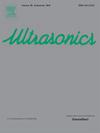基于同轴共焦双频聚焦超声和涡旋光束的稳定声悬浮
IF 3.8
2区 物理与天体物理
Q1 ACOUSTICS
引用次数: 0
摘要
声悬浮通过声辐射力(ARF)使不同材料和尺度的物体悬浮,具有非侵入性、非接触性、深度穿透性、无标签性和生物相容性等优点。然而,由于缺乏捕获力和推进力,仅使用聚焦超声(FU)或聚焦声涡(FAV)来实现稳定悬浮仍然具有挑战性。本研究提出了一种稳定的声悬浮方案,该方案采用同轴共焦双频FU和FAV波束,由聚焦扇形阵列实现。对尺寸远小于波长的物体的力平衡进行了理论分析,并基于高斯科夫势计算了轴向和径向的arf。结果表明,悬架性能主要取决于FU的峰值压力,最小阈值由物体重力决定。较高的傅里叶峰值压力会产生较长的向上推进轴向范围,其特征是较低的阈值高度和较高的稳态高度。捕获力受FAV与FU之间的峰值压力比的控制,最小比值为0.69,与物体的密度和大小几乎无关。提出了一种基于相位采样的高精度双频全息直接数字合成技术,设计了一种能够实时调节频率、压力和相位的8通道驱动系统。采用8元聚焦扇形阵列构建双频FU和FAV波束组成的聚焦场。通过独立调节FAV和FU的峰值压力,成功地实现了聚苯乙烯颗粒沿梁轴在水中的上下运动和稳定悬浮。该方案显著提高了轴向声悬浮的稳定性和精度,验证了其在非接触式操作和无容器处理方面的潜力。此外,双频全息技术可以提高多路复用场的调节灵活性,使其适应各种应用,同时降低源阵列的驱动复杂性。本文章由计算机程序翻译,如有差异,请以英文原文为准。
Stable acoustic levitation based on coaxial confocal dual-frequency focused ultrasound and vortex beams
Acoustic levitation enables the suspension of objects of different materials and scales through the acoustic radiation force (ARF), offering advantages of non-invasive, non-contact, deep penetration, label-free, and biocompatibility. However, achieving stable suspension using focused ultrasound (FU) or focused acoustic vortex (FAV) alone remains challenging due to the absence of both trapping and propulsive forces. This study proposes a stable acoustic levitation scheme that employs coaxial confocal dual-frequency FU and FAV beams, implemented by a focused sector array. Theoretical analyses of force balance for objects with the size much smaller than the wavelength are performed, and ARFs in both axial and radial directions are calculated based on the Gor’kov potential. It is demonstrated that the suspension capability primarily depends on the peak pressure of FU, with the minimum threshold determined by the object's gravity. A longer axial range of upward propulsion, characterized by a lower threshold height and a higher steady-state height, is created by a higher peak pressure of FU. The trapping force is governed by the peak-pressure ratio between FAV and FU, with a constant minimum ratio (0.69) being nearly independent of the density and size of objects. A high-precision dual-frequency holographic direct digital synthesis technology based on phase sampling is developed to design an 8-channel driving system capable of real-time adjustments to frequency, pressure, and phase. Focused fields composed of dual-frequency FU and FAV beams are constructed by an 8-element focused sector array. By independently regulating the peak pressures of FAV and FU, the upward and downward movements and stable suspension of polystyrene particles along the beam axis in water are successfully realized. The proposed scheme significantly enhances the stability and precision of on-axis acoustic levitation, validating its potential for contactless manipulation and container-free processing. Additionally, the dual-frequency holographic technology can improve the regulation flexibility of multiplexed fields, making it adaptable to diverse applications while reducing the driving complexity for source arrays.
求助全文
通过发布文献求助,成功后即可免费获取论文全文。
去求助
来源期刊

Ultrasonics
医学-核医学
CiteScore
7.60
自引率
19.00%
发文量
186
审稿时长
3.9 months
期刊介绍:
Ultrasonics is the only internationally established journal which covers the entire field of ultrasound research and technology and all its many applications. Ultrasonics contains a variety of sections to keep readers fully informed and up-to-date on the whole spectrum of research and development throughout the world. Ultrasonics publishes papers of exceptional quality and of relevance to both academia and industry. Manuscripts in which ultrasonics is a central issue and not simply an incidental tool or minor issue, are welcomed.
As well as top quality original research papers and review articles by world renowned experts, Ultrasonics also regularly features short communications, a calendar of forthcoming events and special issues dedicated to topical subjects.
 求助内容:
求助内容: 应助结果提醒方式:
应助结果提醒方式:


